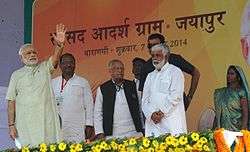Sansad Adarsh Gram Yojana
| Sansad Adarsh Gram Yojana (SAGY) | |
|---|---|
| सांसद आदर्श ग्राम योजना | |
 PM Modi in Jayapur village in Varanasi for Saansad Adarsh Gram | |
| Country | India |
| Prime Minister | Narendra Modi |
| Launched | 11 October 2014 |
| Website |
www |
| Status: Active | |
.jpg) This article is part of a series about |
National policy
|
Sansad Adarsh Gram Yojana (Hindi: सांसद आदर्श ग्राम योजना , abbr.: SAGY) is a rural development programme broadly focusing upon the development in the villages which includes social development, cultural development and spread motivation among the people on social mobilization of the village community.[1] The programme was launched by the Prime Minister of India, Narendra Modi on the birth anniversary of Jayaprakash Narayan, on 11 October 2014.[2]
The distinct feature of this Yojana is that it is (a) demand driven (b) inspired by society (c) based on people's participation.
Objectives
Key objectives of the Yojana include:
- The development of model villages, called Adarsh Grams, through the implementation of existing schemes, and certain new initiatives to be designed for the local context, which may vary from village to village.
- Creating models of local development which can be replicated in other villages.
The plan
Sansad Adarsh Gram Yojana was initiated to bring the member of parliament of all the political parties under the same umbrella while taking the responsibility of developing physical and institutional infrastructure in villages and turn them into model villages.[3] Under this scheme, each member of parliament needs to choose one village each from the constituency that they represent, except their own village or their in-laws village and fix parameters and make it a model village by 2016.
Thereafter, they can take on two or three more villages and do the same by the time the next general elections come along in 2019, and thereafter, set themselves ten-year-long village or rural improvement projects.[1] Villages will be offered smart schools, universal access to basic health facilities and Pucca housing to homeless villagers.[4]
Funding
No new funds are allocated to this Yojana and funds may be raised through :
- Funds from existing schemes, such as the Indira Awas Yojana, Pradhan Mantri Gram Sadak Yojana, Mahatma Gandhi National Rural Employment Guarantee Scheme, and Backward Regions Grant Fund, etc.,
- The Member of Parliament Local Area Development Scheme (MPLADS),
- The gram panchayat’s own revenue,
- Central and State Finance Commission Grants, and
- Corporate Social Responsibility funds.
Roles and responsibilities of key functionaries
| Level | Functionary | Key roles and responsibilities |
| National | Member of Parliament |
|
| Two committees, headed by the Minister of Rural Development, and Secretary, Rural Development, respectively.* |
| |
| State | A committee headed by the Chief Secretary |
|
| District | District Collector |
|
| Village | Gram Panchayat and functionaries of schemes (at various levels) |
|
Strategies
In order to convert the identified village into an Adarsh Gram through the specified activities, the following are the possible strategies:[5]
- Entry point activities to energize and mobilize the community towards positive common action
- Participatory planning exercise for identifying peoples’ needs and priorities in an integrated manner
- Converging resources from Central Sector and Centrally Sponsored Schemes and also other State schemes to the extent possible.
- Repairing and renovating existing infrastructure to the extent possible.
- Strengthening the Gram Panchayats and peoples’ institutions within them
- Promoting transparency and accountability
Adopting Villages
List of villages adopted by MPs, State wise can be viewed here
http://www.mapsofindia.com/government-of-india/saansad-adarsh-gram-yojana.html
List of a few important adoptions :
- Under the scheme, Narendra Modi has adopted Nagepur village his constituency Varanasi in Uttar Pradesh.[6]
- Y. S. Chowdary has adopted Ponnavaram village in Krishna district in Andhra Pradesh.[7]
- Sonia Gandhi adopted Udwa village in her constituency Rae Bareli in Uttar Pradesh.[8]
- Rahul Gandhi adopted Deeh village in his constituency Amethi in Uttar Pradesh.[8]
- V. K. Singh adopted Mirpur Hindu in his constituency Ghaziabad, Uttar Pradesh.[9]
- Ahmed Patel adopted Vandari village in Rajpipada, Gujarat.[10]
- Sachin Tendulkar adopted Puttamraju vari Kandriga(P.R.Kandriga) a village near Gudur in Nellore district of Andhra Pradesh.[11]
- Harish Dwivedi adopted Amodha Khas village in Basti district, Uttar Pradesh.[12]
References
- 1 2 "Prime Minister Modi announces 'Sansad Aadarsh Gram Yojana'". Yahoo News. Retrieved 11 October 2014.
- ↑ "Sansad Adarsh Gram Yojna: Modi has stumped his opponents again". First Post. Retrieved 11 October 2014.
- ↑ "Sansad Adarsh Gram Yojana: Government to put onus on MPs to develop villages". Times of India (ECT). Retrieved 11 October 2014.
- ↑ "Model villages to get smart schools and pucca houses". Indian Express. Retrieved 11 October 2014.
- ↑ "Guidelines of Saansad Adarsh Gram Yojana (SAGY) page no. 12" (PDF).
- ↑ "As it happened: Modi adopts Jayapur village - The Hindu". The Hindu. Retrieved 10 November 2014.
- ↑ "Chowdary adopts Ponnavaram village for development". Retrieved 2015-12-02.
- 1 2 "Gandhis shun PM's Swachh Bharat but embrace Gram Yojna - Times of India". The Times of India. 16 November 2014. Retrieved 16 November 2014.
- ↑ http://economictimes.indiatimes.com/news/politics-and-nation/union-minister-v-k-singh-adopts-mirpur-hindu-village/articleshow/45170371.cms
- ↑ http://economictimes.indiatimes.com/news/politics-and-nation/congress-ahmed patel adopts-vandari-village/articleshow/45170371.cms
- ↑ http://www.aptoday.com/newsnpolitics/sachin-to-arrive-today-in-pr-kandriga-of-nellore/4816/
- ↑ http://www.panchayatportals.gov.in/web/54686_amodha-khas-gram-panchayat/sagy
- ↑ http://www.prsindia.org/theprsblog/?p=3295
.svg.png)